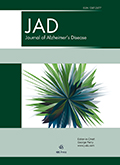Authors: Wang, Yongchun | Jiang, Richeng | Li, Mingxi | Wang, Zicheng | Yang, Yu | Sun, Li
Article Type:
Research Article
Abstract:
Background: Alzheimer’s disease (AD) is the most common type of dementia, causing a huge socioeconomic burden. In parallel with the widespread uptake of single-cell RNA sequencing (scRNA-seq) technology, there has been a rapid accumulation of data produced by researching AD at single-cell resolution, which is more conductive to explore the neuroimmune-related mechanism of AD. Objective: To explore the potential features of T cells in the peripheral blood and cerebrospinal fluid of AD patients. Methods: Two datasets, GSE181279 and GSE134578, were integrated from GEO database. Seurat, Monocle, CellChat, scRepertoire, and singleR packages were mainly
…employed for data analysis. Results: Our analysis demonstrated that in peripheral blood, T cells were significantly expanded, and these expanded T cells were possessed effector function, such as CD8+ TEMRA , CD4+ TEMRA , and CD8+ TEM . Interestingly, CD8+ TEMRA and CD4+ TEMRA cells positioned adjacently after dimensions reduction and clustering. Notably, we identified that the expanded T cells were developed from Naïve T cells and TCM cells, and TEM cells was in the intermediate state of this developing process. Additionally, in cerebrospinal fluid of AD patients, the amplified T cells were mainly CD8+ TEMRA cells, and the number and strength of communication between CD4+ TEM , CD8+ TEM , and CD8+ TEMRA were decreased in AD patients. Conclusions: Our comprehensive analyses identified the cells in cerebrospinal fluid from AD patients are expanded TEMRA or TEM cells and the TEMRA cells communicating with other immune cells is weakened, which may be an important immune feature that leads to AD.
Show more
Keywords: Alzheimer’s disease, analysis of immune characteristics, immune cell subpopulation, single-cell RNA sequencing, TCR repertoire
DOI: 10.3233/JAD-230784
Citation: Journal of Alzheimer's Disease,
vol. Pre-press, no. Pre-press, pp. 1-16, 2023





